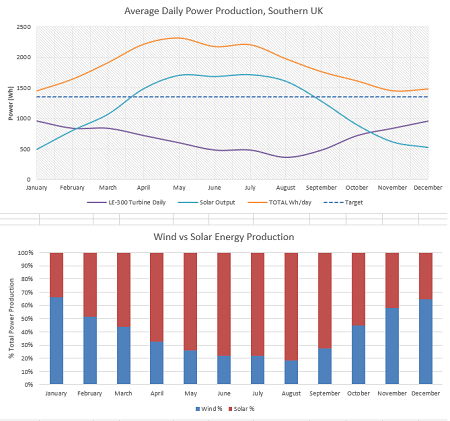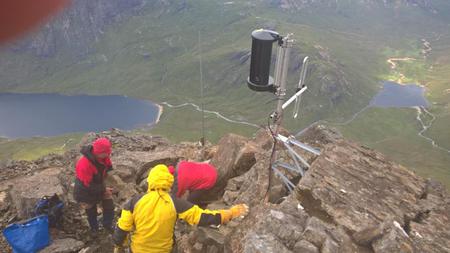When choosing the power source, a combination of two or more is ideal. Solar PV has become relatively inexpensive and wind generators more and more reliable, though it is important to choose one that suits the wind conditions at the location.
 Hybrid systems comprising wind and solar when sized correctly, deliver power 24/7. During the summer, solar irradiation is high; however, PV doesn’t perform so well in the winter, just when it’s windier. More sun, less wind; more wind, less sun.
Hybrid systems comprising wind and solar when sized correctly, deliver power 24/7. During the summer, solar irradiation is high; however, PV doesn’t perform so well in the winter, just when it’s windier. More sun, less wind; more wind, less sun.
As you can see from the graphs on the right, wind and solar compliment each other well. In the top graph, you can see the individual contributions of wind and solar month by month over a year. Using this data in a real situation, the combined effect of wind and solar in the bottom graph meets the customers needs (dotted line) for the 12 months of the year.
Another advantage of using a combined wind/solar hybrid system is that compared to a solar only system, it can help to prevent deep discharge of the battery over night therefore prolonging battery life. As batteries are often a significant part of the cost of an off-grid renewable system, this is very important.
There are two main types of solar panels available: monocrystalline and polycrystalline. In general, monocrystalline panels are preferred for their higher efficiency – a greater ability to convert the sun’s energy into power. The SunPower monocrystalline cells manufactured in the US, for example, are 21.5% efficient compared with 12-14% for the standard polycrystalline cells.
Monocrystalline panels are also able to produce more power in low or variable light conditions, such as cloudy days when power input will be reduced so extracting as much energy in these conditions is critical. For installations where space is limited, consider the monocrystalline panels as they deliver the same power with a smaller footprint, in fact the polycrystalline panels are as much as 50% larger for the same amount of power.
Wind plays a particularly important role in temperate zones above a latitude of 55oN when contribution from PV can be less than 10% during the winter. At these latitudes the sun is low in the sky during the winter so PV needs to be installed at an angle of 45% to capture as much energy as possible.
Where off-grid power is required in a remote location and the system is mission critical, a generator or the greener equivalent, methanol fuel cells, are used as a back-up. Solar and wind provide the bulk of the power with fuel cells kicking in when batteries reach a pre-defined level of discharge. However, the operating costs are high (not just the cost of the fuel cell cartridges but also the need for onsite visits to refuel); for inaccessible places this can be significant.
Fit and forget in harsh locations
 Sites where winds regularly gust to more than 60mph (27m/s) or temperatures drop to -40oC are considered harsh. Small wind turbines are designed to be efficient in everyday low wind speeds and to be quiet, cost effective and responsive. Unfortunately, these very characteristics mean that the traditional horizontal axis wind turbine falls foul of the exponentially increasing magnitude of force and energy that is unleashed by winds of 80-100mph. To power remote equipment in harsh locations, a special type of wind turbine is required – vertical axis turbines.
Sites where winds regularly gust to more than 60mph (27m/s) or temperatures drop to -40oC are considered harsh. Small wind turbines are designed to be efficient in everyday low wind speeds and to be quiet, cost effective and responsive. Unfortunately, these very characteristics mean that the traditional horizontal axis wind turbine falls foul of the exponentially increasing magnitude of force and energy that is unleashed by winds of 80-100mph. To power remote equipment in harsh locations, a special type of wind turbine is required – vertical axis turbines.
The rotor blades on vertical axis turbines with the drag-style ‘savonious’ rotor design rotate at the speed of the wind (as seen here with the Leading Edge LE-v50 wind turbine). The very fact that this design is less efficient at capturing the energy in the wind means it can survive wind speeds of up to 80mph, which would otherwise destroy a horizontal axis wind turbine. When it comes to powering equipment located in mountainous or coastal areas, the vertical turbines are essential kit in providing off-grid power reliably in these harsh environments, with the minimum of maintenance.
Successful deployment of an off-grid system depends on choosing the right combination of power sources – solar, wind, generator, fuel cells – for the location in mind.
The result is a fit and forget solution, delivering power 24/7. And for added peace of mind, there are some excellent web-based monitoring tools that allow the system to be checked remotely, just to be 100% sure.




